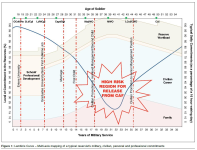Interesting, and largely accurate IIRC
Given all the current talk about
hashtag#recruiting and
hashtag#retention in the
Canadian Armed Forces | Forces armées canadiennes, I thought I would resurrect this old multi-axis mapping of the career of a
hashtag#Reservist from
hashtag#Canadian hashtag#Military Journal (Vol. 16, No. 2, Spring 2016).
In moving through the graph, the typical reservist begins their military career with very little other than school and the military on their daily plate of events – this trend continues until the member completes their academic training and moves to the work force. As the member’s military, civilian, and personal life continues to develop, each element becomes more demanding on their available time in a given day. As these demands become more pronounced, the member becomes progressively less involved with the unit’s activities and training, illustrated by the figure’s blue inverted parabolic line. In many cases, the member is forced to make choices to forgo progression in one professional career in favour of another.
Given the reality that a reservist’s military career does not ‘pay the mortgage,’ it is usually this career that tends to suffer. The member then becomes progressively less involved, and in turn, less attached to the unit and its regular activities until said member reaches a decision point, whereby the member either accepts that they remains in the reserves at a rank and position below their actual level of competency, or simply releases.
There is so much potential in the Canadian Reserves as an institution. It assists young people pay for school, gives them part-time work during the school year and full-time work in the summer. For working professionals it offers active leadership training and most importantly an opportunity to be part of something bigger than ones self.
Unfortunately, this value proposition has not retained its once poignant relevance to most Canadians and perhaps that means it needs to be modernized in a manner that speaks to those in search of a vehicle to give back while gaining skills and purpose.
Given all the current talk about #recruiting and #retention in the Canadian Armed Forces | Forces armées canadiennes, I thought I would resurrect this old… | 29 comments on LinkedIn

www.linkedin.com
View attachment 81678





